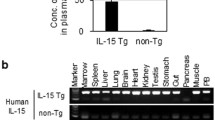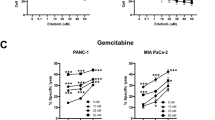Summary
A human tumor cell line designated SU.86 has been established from a moderate-to-poorly differentiated pancreatic carcinoma of ductal origin specifically for adoptive immunotherapy studies. This line was characterized as to its ability to be lysed in vitro by autologous and allogeneic lymphokine-activated killer (LAK) and natural killer cells and to grow in nude mice. SU.86 has been growing continuously in cell culture for more than 100 passages since 22 September 1986. Transplantation orthotopically and heterotopically into athymic Swiss nude mice showed that tumor take was 100% in the orthotopic position when young (4 to 6 wk old) mice were used and 0% when adult (8 wk old) mice were used (P=0.004). In the heterotopic position (subcutaneous), tumor take was 100% in neonate (2 to 3 wk old) and young mice and 50% in adults. The rate of tumor growth was inversely correlated with age (P<0.001). The histologic pattern is similar to that observed in most human pancreatic carcinomas with pseudoglandular structures and frequent mitotic figures. SU.86 has a doubling time of 77 h in vitro and produces carcinoembryonic antigen, 594 ng/106 cells in 3 d. Chromosomal analysis shows heterogeneity with two notable cell subpopulations. The cell line is moderately sensitive to lysis by LAK cells in a standard, 4-h chromium-51 release assay (35.4±4.0%). When grown together with LAK cells in vitro, it is lysed completely in culture in 8 to 15 d, depending on the serum concentration.
Similar content being viewed by others
References
Dissin, J.; Mills, L. R.; Mains, D. L., et al. Experimental induction of pancreatic adenocarcinoma in rats. JNCI 55:857–864; 1975.
Townsend, C. M.; Franklin, R. B.; Gelder, F. B., et al. Development of a transplantable model of pancreatic duct adenocarcinoma. Surgery 92:72–78; 1982.
Reddy, J. K.; Rao, M. S. Pancreatic adenocarcinoma in inbred guinea pigs induced byN-methyl-N-nitrosourea. Cancer Res 35:2269–2277; 1975.
Hewitt, H. B. Animal tumor models and their relevance to human tumor immunology. J. Biol. Response Modif. 1:107–119; 1982.
Rapp, H. J. Appropriateness of animal models for the immunology of human cancer. Cancer Res. 39:4285–4287; 1979.
Herberman, R. B. Counterpoint: Animal tumor models and their relevance to human tumor immunology. J. Biol. Response Modif. 2:39–46; 1983.
Baldwin, R. W. Relevant animal models for tumor immunotherapy. Cancer Immunol. Immunother. 1:197–198; 1976.
Dexter, D. L.; Matook, G. M.; Meitner, P. A., et al. Establishment and characterization of two human pancreatic cancer cell lines tumorigenic in athymic mice. Cancer Res. 42:2705–2714; 1982.
Lieber, M.; Mazzatta, J.; Nelson-Rees, W., et al. Establishment of a continuous tumor-cell line (PANC-1) from a human carcinoma of the exocrine pancreas. Int. J. Cancer 15:741–747; 1975.
Okabe, T.; Yamaguchi, N.; Ohsawa, N. Establishment and characterization of a carcinoembryonic antigen (CEA)-producing cell line from a human carcinoma of the exocrine pancreas. Cancer 51:662–668; 1983.
Yunis, A. A.; Arimura, G. K.; Russin, D. J. Human pancreatic carcinoma (MIA PaCa-2) in continuous culture: sensitivity to asparaginase. Int. J. Cancer 19:128–135; 1977.
Akagi, T.; Kimoto, T. Establishment and characteristics of a human pancreatic cancer cell line (HCG-25). Acta Pathol. Jpn. 27:51–58; 1977.
Kyriazis, A. P.; McCombs, W. B.; Sandberg, A. A., et al. Establishment and characterization of human pancreatic carcinoma cell line SW-1990 in tissue culture and the nude mouse. Cancer Res. 43:4393–4401; 1983.
Tan, M. H.; Chu, T. M. Characterization of the tumorigenic and metastatic properties of a human pancreatic tumor cell line (ASPC-1) implanted orthotopically into nude mice. Tumor Biol. 6:89–98; 1985.
Dobrynin, Y. V. Establishment and characteristics of cell strains from some epithelial tumors of human origin. JNCI 31:1173–1195; 1963.
Kaku, M.; Nishiyama, T.; Yagawa, K., et al. Establishment of carcinoembryonic antigen-producing cell line from human pancreatic carcinoma. GANN 71:596–601; 1980.
Rosenberg, S. A.; Grimm, E. A.; McGrogan, M., et al. Biological activity of recombinant interleukin-2 inEscherichia coli. Science 223:421–1415; 1984.
Wang, S. A.; Lu, S. D.; Mark, D. Site-specific mutagenesis of the human interleukin-2 gene: structure-function analysis of the cysteine residues. Science 224:1431–1433; 1984.
Larick, J. W.; Dyer, B. J. Mycoplasma testing. In: Engleman, E. G.; Foung, S. K. H.; Larrick, J., et al. eds. Human hybridomas and monoclonal antibodies. New York: Plenum Press; 1985:430–432.
Felder, R. A.; MacMillan, R. H.; Burns, D. E. Two monoclonal based assays for carcinoembryonic antigen compared. Clin. Chem. 33:700–704; 1987.
Strausser, J. L.; Rosenberg, S. A.In vitro growth of cytotoxic human lymphocytes. I. Growth of cells sensitizedin vitro to alloantigens. J. Immunol. 121:86–96; 1978.
Lozzio, C. B.; Lozzio, B. B. Human chronic myelogenous leukemia cell line with positive Philadelphia chromosome. Blood 45:321; 1975.
Yunis, J. J. High resolution human chromosomes. Science 191:1268–1270; 1976.
Gibas, L. M.; Jackson, L. G. A new hypotonic solution for cytogenetic analysis of leukemic bone marrow cells. Karyogram 11:91–92; 1985.
Seabright, M. A rapid banding technique for human chromosomes. Lancet 2:971–972; 1971.
Freiman, J. A.; Chalmers, T. C.; Smith, H., et al. The importance of beta, the type II error and sample size in the design and interpretation of the randomized control trial. N. Engl. J. Med. 299:690–695; 1978.
Harnden, D. G.; Klinger, H. P., eds. An international system for human cytogenetic nomenclature (1985): report of the standing committee on human cytogenetic nomenclature. Birth Defects Orig. Artic. Ser. 21 (1); 1985.
Kobari, M.; Matsuno, S.; Sato, T., et al. Establishment of a human pancreatic cancer cell line and detection of pancreatic cancer associated antigen. Tohoku J. Exp. Med. 143:33–46; 1984.
Fogh, J.; Fogh, J. M.; Orfeo, T. One hundred and twenty-seven cultured human tumor lines producing tumors in nude mice. JNCI 59:221–226; 1977.
Grant, A. G.; Duke, D.; Hermon-Taylor, J. Establishment and characterization of primary human pancreatic carcinoma in continuous cell culture and in nude mice. Br. J. Cancer 39:143–151; 1979.
Rosenberg, S. A. Adoptive immunotherapy of cancer using lymphokine activated killer cells and recombinant interleukin-2. In: De Vita, V. T.; Hellman, S.; Rosenberg, S. A., eds. Important advances in oncology, Philadelphia: J. B. Lippincott Company; 1986:55–91.
Hanna, N. Expression of metastatic potential of tumor cells in young nude mice is correlated with low levels of natural killer cell-mediated cytotoxicity. Int. J. Cancer 26:675–680; 1980.
Author information
Authors and Affiliations
Rights and permissions
About this article
Cite this article
Drucker, B.J., Marincola, F.M., Siao, D.Y. et al. A new human pancreatic carcinoma cell line developed for adoptive immunotherapy studies with lymphokine-activated killer cells in nude mice. In Vitro Cell Dev Biol 24, 1179–1187 (1988). https://doi.org/10.1007/BF02624187
Received:
Accepted:
Issue Date:
DOI: https://doi.org/10.1007/BF02624187




